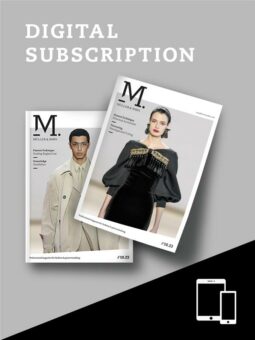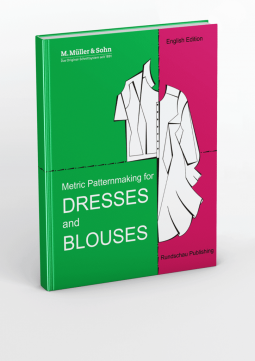Which Needle is the Right One?
Deutsch
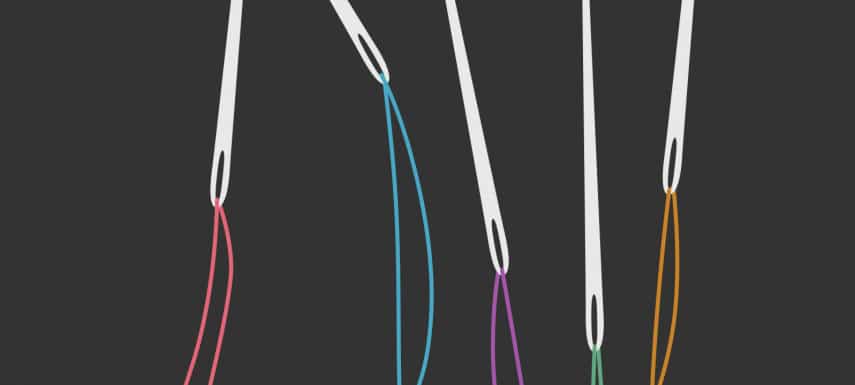
The sewing needle is an important factor in the sewing process, both for sewing and for the subsequent seam. Unfortunately, you often can’t tell by looking at the needle whether it is good or bad. The results are generally all the more shocking. Therefore, the general rule should be: Only use high-quality sewing needles! You can find out what you should look out for when choosing the right sewing needle here.
This article is a excerpt from our german speaking reference books Atelier – Fachwissen aus der Praxis Teil 1 (Currently not available).
Content
What determines the quality of a needle?
The uniformity from needle to needle is crucial, the behaviour must be calculable, any deviation in quality is a nuisance. In addition to the shape of the point, the eye of the needle is important, the thread must be able to slide through easily and must not rub. Most people are not aware of the fact that, for example, when double lockstitching, the sewing thread is pulled back and forth through the eye 20 to 60 times at one point and this under tension before it is in the needle. If the sewing needle is not in perfect condition, the thread will be pushed up, which is referred to by experts as “raveling”, which at least leads to a weakening of the seam, but generally to thread breakage. Only high-quality sewing needles of consistent quality prevent such sewing faults. The solution is to use a new needle.
The needle size
The needle size is specified as the diameter in the shank area. The needle size NM 80 therefore has a diameter of 0.8 mm, a needle size NM 100 therefore has a diameter of 1.0 mm. This “metric number”, abbreviated NM, is actually the usual size designation for sewing needles. In some cases, however, the old Singer needle size designation can still be found.
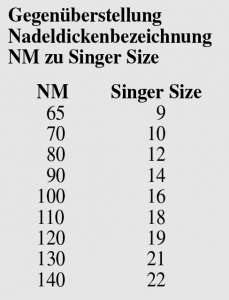
The needle size must be matched to the various parameters such as sewing thread, sewing material / fabric and sewing machine. Of course, the person operating the sewing machine should not be forgotten, as fine sewing needles, e.g. the NM 65, also require careful handling. This fine needle is often described as unsuitable because it breaks again and again. The reason for this is usually that the worker believes that they need additional support during transport, whereby the fine needle is deflected and then turns up on the needle plate or hook. The result is a broken needle.
Matching sewing needle to sewing thread
The sewing needle must be matched to the sewing thread cross-section in such a way that the sewing thread is not slowed down in its movement in the eye of the needle. If the needle is too fine, the thread is slowed down in the eye of the needle and higher thread tension is required. This leads to seam puckering. If the needle is too fine, the sewing thread can also chafe in the eye and break. A needle that is too thick is also unfavourable, the thread is not guided sufficiently in the long groove, the stitch binding is made more difficult and skipped stitches occur. The risk of skipped stitches increases with materials of different thicknesses, e.g. when moving from two to four layers of denim, but also when working in the round, partly due to needle deflection. Some needle manufacturers offer special needles, such as the SERV 7 from Schmetz, which are not sufficiently guided in the long groove, making stitch binding more difficult and possibly causing skipped stitches.
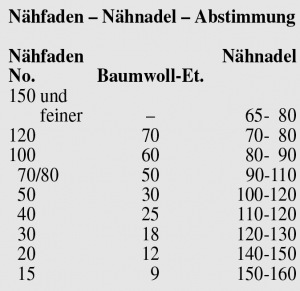
The illustration shows the match between sewing machine needle and sewing thread for polyester and cotton sewing threads. The needle sizes indicated should only be used as a guide, whereby the finer needle sizes indicated should not be exceeded if possible, while the larger sizes should not be considered as problematic. However, smooth continuous sewing threads on a polyester template are also used, in the fine sizes for staffing and pricking, and in coarser sizes for leather goods and the like. When using continuous polyester sewing threads, the needle size can be selected one size finer.
Avoiding skipped stitches
The problem often arises with extremely elastic fabrics, material layers of different thicknesses and cross seams. In the case of particularly elastic fabrics, e.g. for bras, bodies, swimwear etc., the material tends to flutter. This is caused by the moving sewing needle, the hook loop can be reduced in size and skipped stitches occur. The risk of skipped stitches increases with materials of different thicknesses, e.g. when moving from two to four layers in jeans, but also in circular sewing, due to needle deflection, among other things. Needle manufacturers offer special needles (SERV 7 from Schmetz) with a hump in the groove area and an additional shank reinforcement. The hump improves the loop formation and thus prevents skipped stitches. The shank reinforcement provides greater stability, which significantly reduces the deflection of the sewing needles, especially with fine gauges.
Which needle point is needed for which fabric?
What important lace moulds are there in the field of textile processing and what problems do they solve?
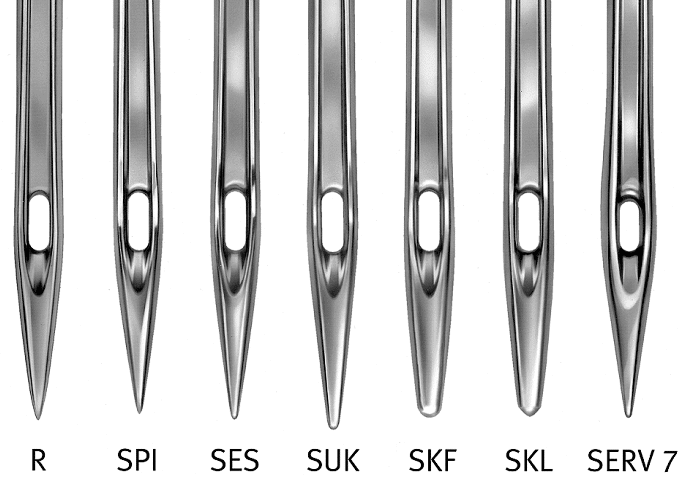
Normal round point – R: The round point is actually referred to as the standard point shape, which is why needle systems with a normal round point often have no designation or are labelled with the letter “R”, e.g. System 134(R). They are used for light fabrics, thin, coated materials, for making up furs and the like.
Round point – SPI: This needle is characterised by a very slim, pointed point that allows precise piercing of densely woven and coated materials and produces a uniform seam appearance. Typical areas of application are microfibre fabrics or foils. This point shape is mainly used against displacement puckering, as the slim, pointed point can pierce with little force. The best results are achieved in conjunction with the following settings. Needle as thin as possible (NM 65-70). No high stitch density (ideally 3-4 stitches/cm). Fine sewing thread of size No. 120 or better No. 150. Use of the double chain stitch due to the stitch interlacing outside the fabric. The advantages of this point shape are also evident in the avoidance or at least reduction of thread pulls, which can affect the appearance of the fabric. When using fabrics with covered elastomer threads, this point shape prevents the threads from coming out of the fabric.
Small ball point – SES: The small ball point displaces fabric and stitch threads, piercing directly into the gaps and thus preventing damage to the material. It is mostly used for fine and medium knitted fabrics, as well as for light to heavy fabrics and laminated materials. But also for upholstery fabrics, which often have knitted fabric on the underside.
Medium ball point – SUK: This point is even more rounded than the previously mentioned small ball point labelled SES. It is used in the denim industry, especially for stone- and sandwashed qualities in combination with correspondingly thick needles. It is also used for corsetry when using fine needle sizes. In addition to the problem of damage to the material, which can be prevented with the right point shape, the reliability of the stitch formation plays an important role. This is why the special needle with the additional designation SERV 7 with the hump formation in the eye area should be used here.
Large ball point – SKF: This needle has a large ball point, which is strongly rounded. It enables punctual displacement of coarse, wide stitches without piercing the material threads. It has also proved its worth when working with fine elastic materials with elastomer threads wound around them.
Special ball point – SKL: This needle has a very wide, strongly rounded point and is mainly used for coarse knitwear and knitted fabrics, as well as for processing medium to heavy elastic materials in combination with covered elastomer threads. Needles for blind stitch work: There are specially curved needles on the market for this type of sewing work. The special feature is an eccentric point that enables very precise piercing. A rectangular shank cross-section ensures very high stability, which is particularly important for very fine needles of thickness NM 60, as this prevents deflection of the needle and thus skipped stitches. Typical problem areas are transitions at the hem, where a skip stitch results in the seam opening completely. Of course, there are also a number of other special needles and point shapes that are used for sewing leather.
However, this mainly concerns heavy leather qualities for shoes, bags, suitcases and the like, but not garment leather. Garment leather is generally soft and is also sewn together with the fabric, at least when sewing in the lining, so needles with a cutting point are problematic. It is normally sufficient to use the SPI point shape, which, due to its point, allows easy penetration even with foils. Smearing of the needle by textiles with a surface coating is more of an industrial problem than a handicraft problem. In combination with high sewing speeds, the needle can heat up so much that these coatings become soft, partially melt and deposit on the needle. The long groove becomes clogged and sometimes even the eye of the needle closes, resulting in thread breakage. Special needles with a Teflon coating on the surface, known by names such as Blukold needles, serve as a solution here. However, care must be taken not to damage the needle, otherwise the desired effect will no longer be achieved.
The needle as a problem solver: Not only must the sewing needle be of high quality, it must also be correctly selected. First and foremost, this applies to the system used to create a seam. However, it is just as important to choose the right needle size and point shape.
You can find more interesting tips and tricks on learning to sew and how to use a sewing machine, needle and thread in the articles
- Which thread is the right one?
- Avoiding pulls when sewing
- The right thread tension
- The sewing thread numbering


